15 Types of Hawks: Where to Find Them & Their Specialty?
Hawks are birds of prey that are magnificent for their hunting, aerial, and acrobatic skills. Whether you are a birdwatcher or a nature enthusiast, this is where you will come to know about the types of hawks in detail.
So, what are the different types of hawks? There are about 270 species of hawks. The most common ones include Red-tailed, Sharp-shinned, Cooper, and Ferruginous Hawks. Great Black and Northern Goshawks are also commonly found. Similarly, Harris, Cranes, Roadside, Swainos, and many more hawks will come across as well.
Well, this just states the names of a few commonly found different types of hawks. There are more, and to know about them properly, you need to read along as we have got every piece of information here. Let’s get started.
15 Types of Hawks That You Need to Know About
While there are about 270 different species of this bird, we noted down the most interesting 15 different kinds of hawks. So, take a look to learn about all their insights in detail.
1. Red-Tailed Hawk
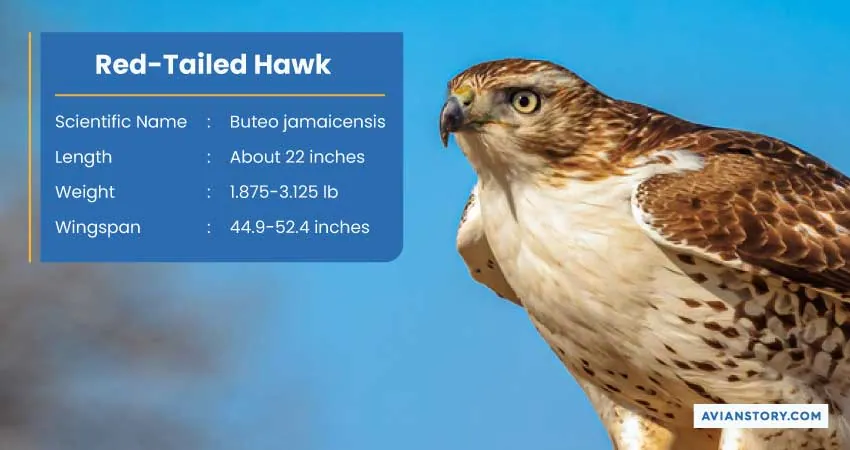
| Scientific Name | Length | Weight | Wingspan |
| Buteo jamaicensis | About 22 inches | 1.875-3.125 lb | 44.9-52.4 inches |
Red-tailed Hawks are one of the hawk species commonly found in the USA, Mexico, and Canada in the season of breeding. They are often seen on telephone poles and on electrical power systems at times as well, for which they go through a few issues.
These hawks are brown in color in the upper body and whitish under. They move to Northern America in winter but found in Central USA and Mexico all year round.
Talking about their residence, their nests are found anywhere, starting from fields to parks.
A Red-tailed Hawk can scream with a high pitch which is very significant. Their scream is used in movies for birds’ sounds.
2. Sharp-Shinned Hawk
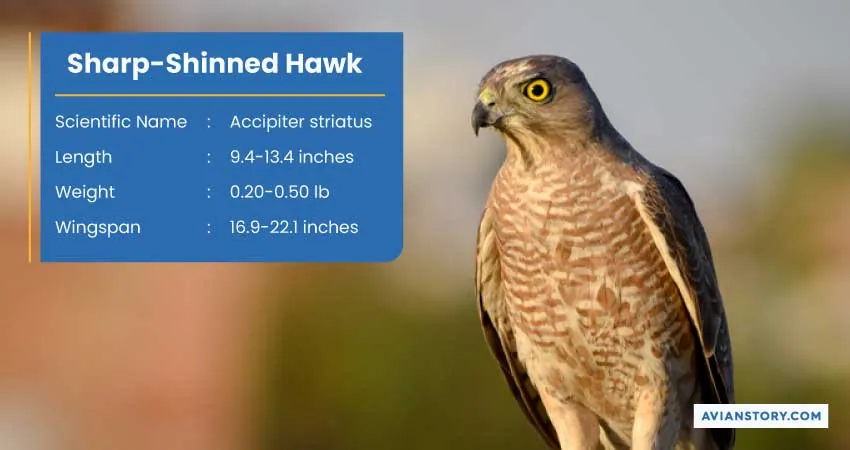
| Scientific Name | Length | Weight | Wingspan |
| Accipiter striatus | 9.4-13.4 inches | 0.20-0.50 lb | 16.9-22.1 inches |
Sharp-Shinned Hawks migrate to Northern Canada and the USA to breed. However, they spend winter in Mexico and Central America but can be found in Northern America all year round.
This is the smallest hawk in North America and they use their nimble feet to catch and pierce their prey. Sharp-skinned hawks are very good at catching their prey with feet.
3. Cooper’s Hawk
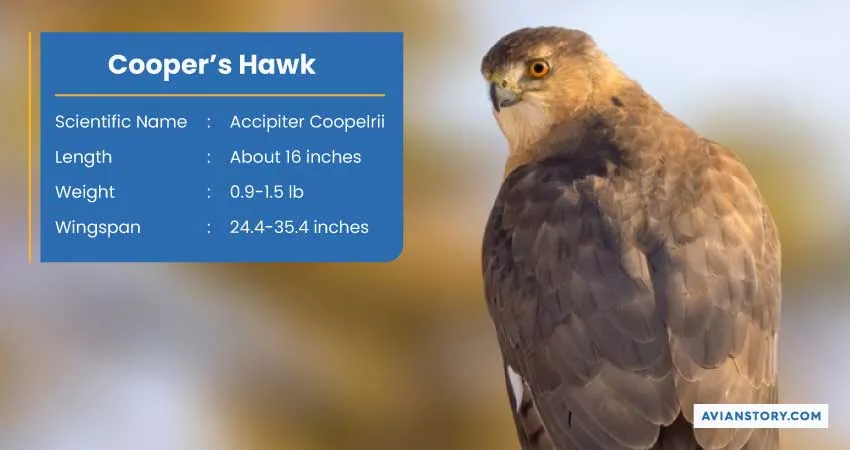
| Scientific Name | Length | Weight | Wingspan |
| Accipiter striatus | About 16 inches | 0.9-1.5 lb | 24.4-35.4 inches |
Cooper’s Hawks do not usually migrate and stay all over the US. However, they also prefer to breed in Southern Canada. You can find these hawks in the USA throughout the year and in Southern Canada in winter.
These birds are used to eating other smaller birds and like to stay in places with backyard bird feeders.
4. Rough-legged Hawk

| Scientific Name | Length | Weight | Wingspan |
| Buteo lagopus | 18.5-20.5 inches | 1.6-3.1 lb | 52.0-54.3 inches |
Round-legged Hawks generally breed in the Arctic region and can be found there all the year. However, they move to the southern part of the US in winter eventually as they prefer residing in deserts and open lands.
This bird catches its prey from a perch by swooping down on it. A round-legged hawk consumes about a quarter pound of food every day.
5. Red-Shouldered Hawk
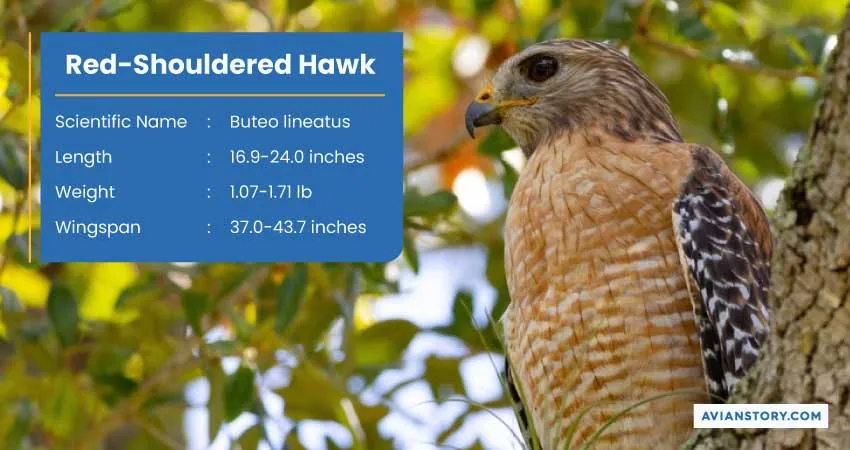
| Scientific Name | Length | Weight | Wingspan |
| Buteo lineatus | 16.9-24.0 inches | 1.07-1.71 lb | 37.0-43.7 inches |
You can find Red-shouldered Hawks commonly in the Eastern and Southeastern United States all year. You may also notice them in Western California, especially in winter but that is not very usual.
These hawks can be distinguished by their rich and reddish chestnut plumage and are alternatively known as red-headed hawks. This showcases a marbled pattern on the wings and is accompanied by distinct bars on the breast.
Their tails feature prominent bars, while their eyes are a striking shade of pitch black. These birds consume small mammals, snakes, and amphibians.
6. Ferruginous Hawk
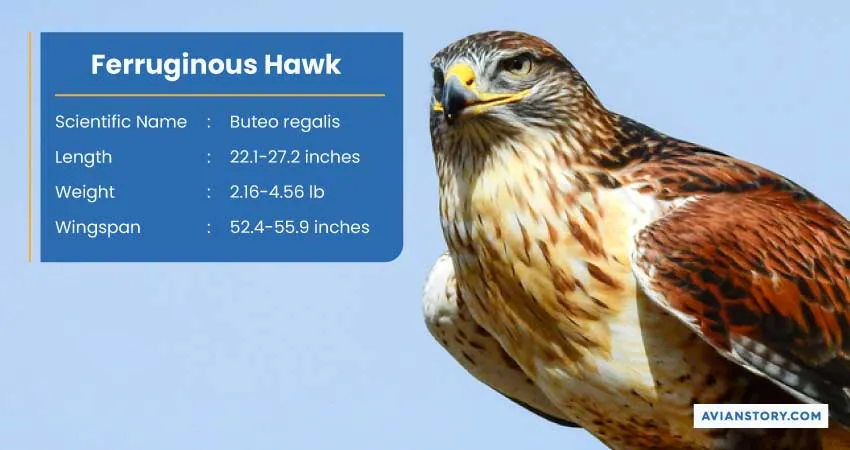
| Scientific Name | Length | Weight | Wingspan |
| Buteo regalis | 22.1-27.2 inches | 2.16-4.56 lb | 52.4-55.9 inches |
Ferruginous Hawks are found in open plains and deserts in the western US all year and is considered to be the largest hawk in North America. They are found in the southern part of the US in winter.
These birds tend to appear in a group and try to hunt prairie dogs, squirrels, or small mammals.
They have a white belly with brown feathers and rusty red marks all around their body.
7. Great Black Hawk

| Scientific Name | Length | Weight | Wingspan |
| Buteogallus urubitinga | 22-25 inches | 2.4 lb | 47-54 inches |
You can see Great Black Hawks in Central and Southern USA very commonly throughout the year. These are also known as Black and White-tailed Hawks. However, these birds do not move to the northern part of Mexico.
They are black and quite big. They like to feed on birds, fish, crabs, and amphibians.
8. Northern Goshawk

| Scientific Name | Length | Weight | Wingspan |
| Accipiter gentilis | 20.9-25.2 inches | 1.40-3 lb | 40.5-46.1 inches |
Northern Goshawks are found from Tennessee to California to Alaska and almost the entire Canada. You may also see them in a few parts of Mexico in a very small number but in Winter.
Their nest can be found in ponderosa pines and aspens. These birds are extremely territorial, which means they will attack anyone if they find anyone dangerous.
Note that these birds are large, so getting attacked by them could be quite dangerous.
9. Harris’s Hawk
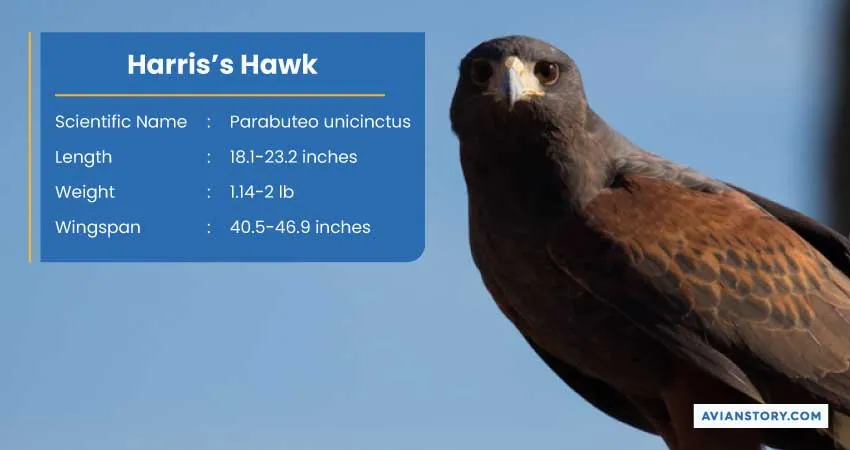
| Scientific Name | Length | Weight | Wingspan |
| Parabuteo unicinctus | 18.1-23.2 inches | 1.14-2 lb | 40.5-46.9 inches |
Harris’s Hawks reside in Arizona, Texas, and New Mexico all the year. They like to build their habitat in desert lowland and mesquite brushland.
However, they have recently started to adapt to living in urban and suburban areas for food and water, especially in winter.
These birds generally move in groups to hunt their prey. A great bonding between these birds is seen as they bring food to their fellow birds who are injured.
10. Crane Hawk
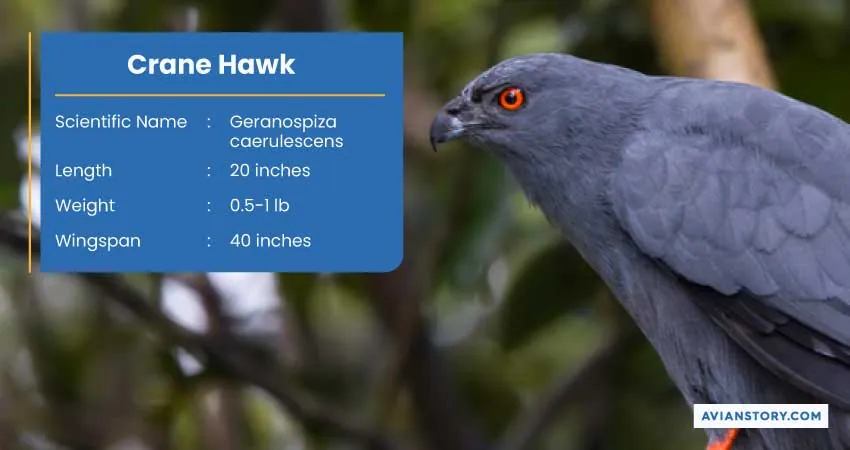
| Scientific Name | Length | Weight | Wingspan |
| Geranospiza caerulescens | 20 inches | 0.5-1 lb | 40 inches |
Although Crane Hawks are found rarely these days, they can still be seen in Central and South America from time to time.
These birds have long legs by which they pull off their prey from a tree. Crane Hawks are gray in color and small in size.
11. Roadside Hawk

| Scientific Name | Length | Weight | Wingspan |
| Rupornis magnirostris | 12-16 inches | 0.5-0.7 lb | 30 inches |
Roadside Hawks are found mainly in the central and southern parts of the US. They move to Mexico in Winter. These birds are quite small in size.
They are mainly found in roadside telephone wires and trees in the forests. Moreover, the birds consume any living or non-living things that are small in size, especially rodents and amphibians.
12. Swainson’s Hawk
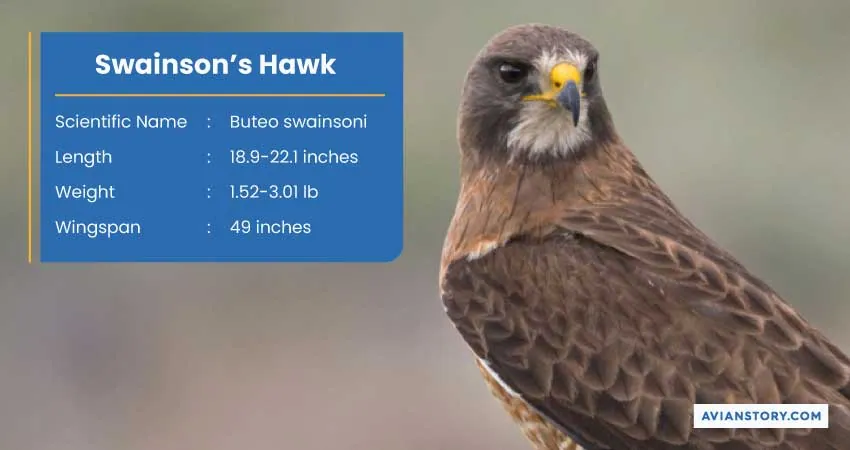
| Scientific Name | Length | Weight | Wingspan |
| Buteo swainsoni | 18.9-22.1 inches | 1.52-3.01 lb | 49 inches |
Swainsos’s Hawks spend their summer in North America but move to Argentina in winter. Many people enjoy this long migration of birds from North America.
These birds feed on insects like dragonflies and grasshoppers. However, chick Swainsos consume rodents and reptiles.
13. Short-tailed Hawk
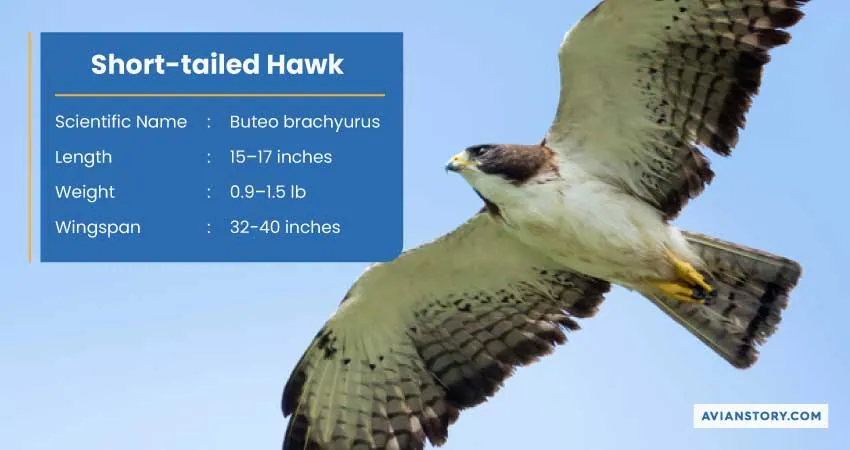
| Scientific Name | Length | Weight | Wingspan |
| Buteo brachyurus | 15–17 inches | 0.9–1.5 lb | 32-40 inches |
Short-tailed Hawks are rare today and only seen in Florida in the US. The lower portion of their body is white and the upper portion is black.
As these hawks are studied the least, there is not much information about them.
14. White-tailed Hawk
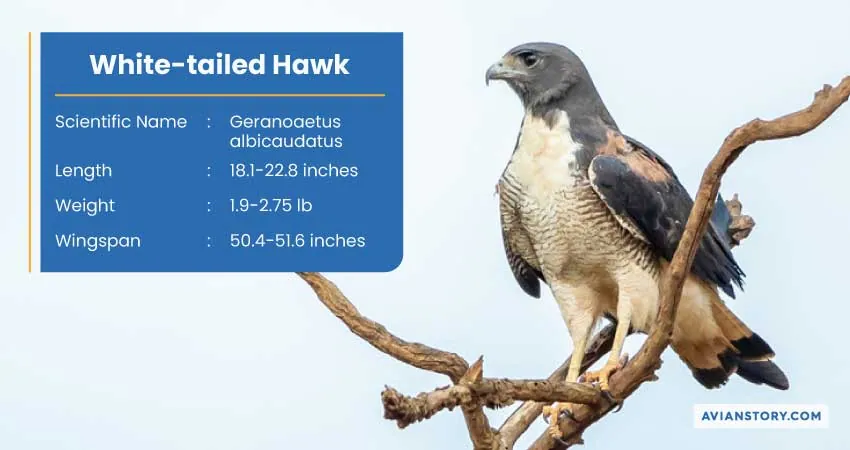
| Scientific Name | Length | Weight | Wingspan |
| Geranoaetus albicaudatus | 18.1-22.8 inches | 1.9-2.75 lb | 50.4-51.6 inches |
You can see White-tailed Hawks if you go to Southern Texas, especially in Rio Grande Valley.
These birds have light underparts with a white tail and their chestnut goes along the shoulders.
15. Northern Harrier
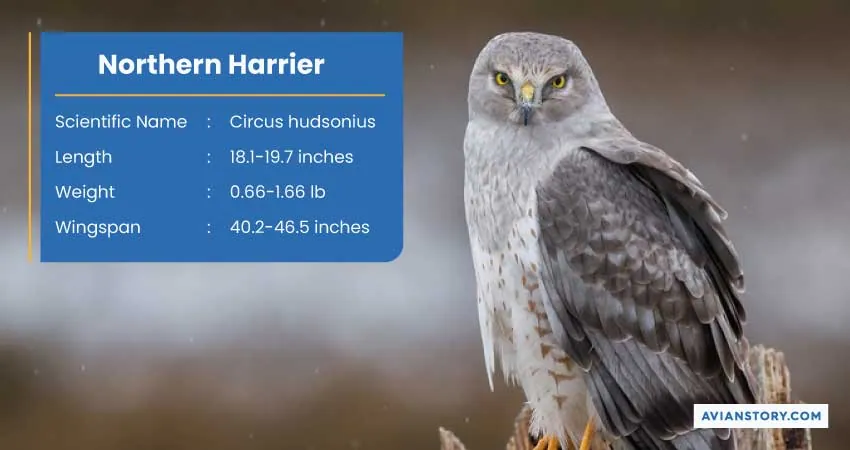
| Scientific Name | Length | Weight | Wingspan |
| Circus hudsonius | 18.1-19.7 inches | 0.66-1.66 lb | 40.2-46.5 inches |
Northern Harriers are commonly found in North America, Alaska, and Canada. Alternatively, these are called Dark Brown Hawks too. However, these birds start migrating to Central America and Mexico in winter.
They hunt prey while flying, especially from open spaces. These birds mainly feed on small mammals and birds. At times, they hunt larger animals and kill them by drowning.
Frequently Asked Questions
Now that you know all about the Hawks, let’s discuss some of the frequently asked questions regarding them.
Are hawks and eagles the same?
Although hawks and eagles are quite similar, they are not the same. In general, eagles are larger than hawks in body size and have longer wingspans too. On the other hand, hawks have more round wingspans than that of eagles. Ultimately, the hawk is a subfamily of eagles.
Which hawk is considered to be the most dangerous?
People consider the Ferruginous Hawk to be the most dangerous among all their types. This is because this hawk is the strongest, which looks very similar to an eagle. These hawks are quite big too.
Are hawks or owls stronger?
Owls are generally seen to be stronger than most of the types of hawks. The body of an owl is stouter, which makes it agile. However, owls are larger and stronger than hawks.
Final Words
Throughout the article, we discussed 15 unique types of hawks and where to find them! We believe you got every necessary insight that you were looking for.
As we have come to an end, here is the last information for you. Hawks generally tend to avoid coming in contact with humans. However, you must know that they can be aggressive and attack humans at any time if they feel disturbed. So it’s best not to interrupt them at all.
